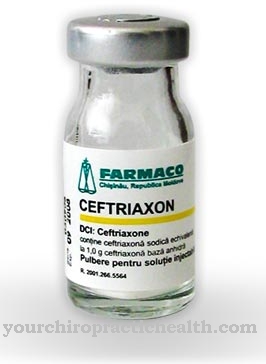Isoflurane is a volatile anesthetic with hypnotic and muscle relaxing effects. As a volatile, halogenated inhalation anesthetic, it is suitable for induction and maintenance of anesthesia for surgical interventions.
What is isoflurane?
Isoflurane belongs on the one hand to the group of flurans and on the other hand to the active ingredient class of inhalation anesthetics. Isoflurane is a volatile anesthetic. As a structural isomer of enflurane, it has been used for anesthesia since 1984. The hypnotic and muscle relaxing effects are considered good. However, the effect is only weakly analgesic.
Isoflurane has the molecular formula C3H2CIF5O. The molar mass is 184.49 g / mol. Isoflaron has a pleasant odor and is in a colorless liquid state at room temperature. The boiling point is 48-49 degrees Celsius. It has a low solubility in water. The compounds dimethyl sulfate and 2,2,2-trifluoroethanol form the synthesis of isoflurane.
Pharmacological effect on the body and organs
The rate of metabolism of isoflurane is extremely low. This has the advantage that it can also be used in patients who have kidney or liver damage. The rate is around 0.2%.
A good hypnotic effect and also muscle relaxing effect are known. The increase in intracranial pressure is slight. Compared to other anesthetic substances, the electrical activity of the CNS is more strongly suppressed. Acetylcholine receptors are suppressed and NMDA receptors are blocked. On the other hand, GABA receptors are activated. This supports the hypothesis that one of the anesthesia mechanisms is based, at least in part, on attenuation by cholinergic cells.
Isoflurane also affects the cardiovascular system. Here it has a vasodilating effect. A significant reduction in peripheral vascular resistance and a drop in blood pressure are the result. The cardiac output remains almost unchanged. The effect on the myocardium is negative, but the myocardial depression is rather small compared to halothane. Isoflurane lowers the myocardial oxygen consumption as well as the coronary vascular resistance without significantly affecting the coronary blood flow rate.
The pungent odor can irritate the airways. This can lead to an urge to cough, bronchial secretion, but also breath hold. Any respiratory depression that may occur is dose-dependent. It must be noted that the pulmonary vascular resistance increases and the lung expandability can temporarily decrease.
A decrease in the respiratory rate is based on a central depression of the respiratory neurons of the medulla oblongata. On the other hand, this causes a reduced contractility of the diaphragm. An increase in arterial PaCO2 occurs during anesthesia in spontaneous breathing. This leads to a lowering of the arterial pH. This can possibly lead to respiratory acidosis.
The decreased blood pressure also affects kidney functions. This reduces the glomerular filtration rate as well as the renal blood flow. The result is decreased urine production. These processes are reversible. The automatic regulation of the kidneys works in humans up to a mean arterial pressure of 70 mmHg. The diuresis is therefore not affected. A nephrotoxic effect could not be demonstrated for isoflurane.
Medical application & use for treatment & prevention
As a volatile, halogenated inhalation anesthetic, isoflurane is not only suitable for induction, but also for maintaining anesthesia. As an initial concentration for induction of anesthesia, the concentration of isoflurane should be 0.5% for an adequate depth of anesthesia in surgical interventions. A surgical depth of anesthesia within 7 to 10 minutes is achieved with a concentration of 1.5 to 3% in the inspiratory air.
A concentration of 1.0 to 2.5% is administered to maintain anesthesia in conjunction with oxygen and nitrous oxide. If isoflurane is given with oxygen only, the dose must be increased by 0.5 to 1%. To achieve additional muscle relaxation, muscle relaxants should be administered.
Isoflurane can also be used in connection with an artificially induced childbirth, with general anesthesia and caesarean section.
Food should not be consumed 8 to 12 hours before the operation with inhalation anesthesia with isoflurane. Age as well as previous illnesses and existing illnesses as well as the use of other medications and the operating area must be taken into account for anesthesia with isoflurane.
You can find your medication here
➔ Medicines for painRisks & side effects
The anesthetic isoflurane causes blood vessels to dilate. Depending on the dosage, it therefore leads to a decrease and an increase in heart rate in relation to arterial blood pressure. The blood flow to the heart is reduced as well as the cardiac output.
With regard to the kidneys, it should be noted that their blood flow is reduced and the glomerular filtration rate is reduced, as is the production of urine. The active ingredient contained reduces the breathability, which is why it is classified as a breath-depressant substance. The mucous membranes can easily become irritated.
In Boston, an experimental laboratory series was able to show that isoflaron, on the one hand, promotes the deposition of amyloids in nerve cells and, on the other hand, increases apoptosis. Processes that are characteristic of Alzheimer's.
Whether inhaled narcotics are also responsible for the frequent postoperative cognitive dysfunction (COPD) in older people has not yet been conclusively clarified. Also, whether a direct damaging effect on the brain cells is to be feared has not yet been conclusively proven neurologically by in-vitro studies.
However, it could be shown that not only the formation of the amyloid beta protein, but also programmed cell death (apoptosis) are promoted by toxic products.












.jpg)



.jpg)










.jpg)
